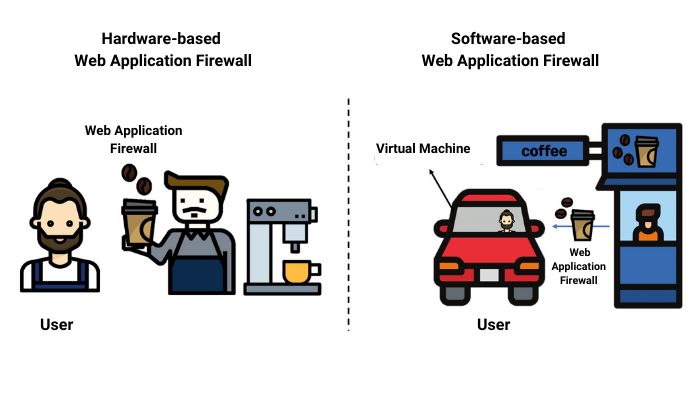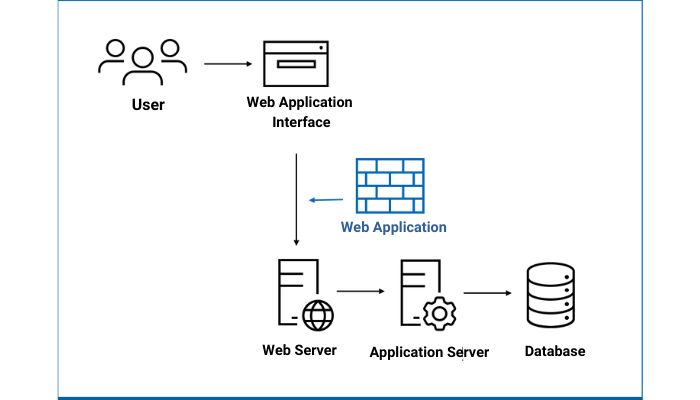Depending on your business environment and purpose, you can build a more effective security system by using a web application firewall that is suitable for you. Today, we will look at the features and advantages, and disadvantages of hardware, software, and cloud-type web firewalls.
Let’s take a look at how web application firewalls are hosted and where they are located within the network. As shown in the figure below, web application firewalls secure traffic between the web servers and web applications such as the browser that we use.
Three types of Web Application Firewall (WAF)
1. Hardware-based Web Application Firewall
A common type of WAF is the hardware-type web application firewall, which is installed within the Local Area Network (LAN). LAN is a network connecting devices in close proximity, together in one area. An Operating System (OS) is usually installed on the hardware and supports software configuration and updates. The main advantage of a hardware-type WAF is its high speed and performance. Because it is physically located near the server, data packets can be filtered and delivered quickly. This can be beneficial when protecting the application area. However, the cost of purchasing, installing, and maintaining hardware is rather high. What kind of organization should use a hardware WAF?This type of web application firewall is recommended for large organizations with tens of thousands of visitors entering the website every day. This is because large organizations must support speed and performance in order to effectively serve many clients. In fact, many large enterprises prioritize speed and performance over the high cost of a hardware WAF. Penta Security’s Intelligent Web firewall WAPPLES is a hardware-type firewall that comes with the Application Delivery Controller (ADC). Thanks to the controller, the engineer in charge don’t have to adopt a separate ADC. In addition, while general web firewalls are detected by pattern matching, WAPPLES operates based on the patented logic analysis detection engine COCEP. COCEP is a key technology that maximizes detection speed and performance.
2. Software-based Web Application Firewall (WAF)
 Without a hardware device, a software-based WAF is installed on top of a virtual machine (VM). A virtual machine is an environment where multiple users can use a computer system at the same time by dividing the system as if there were several small computer systems. The only difference is that users need a hypervisor that can enable multiple systems to operate on a single computer. To put it figuratively, a hardware-type web firewall is when the user goes to a cafe and purchases coffee. A software-type web firewall is when the user chooses a place, brings their car, and grabs a cup of coffee through the drive-through window. The advantage of a software-type web firewall is its flexibility. Not only can the software WAF be available to in-house systems, it can also connect virtual machines to cloud-based web and application servers at a lower cost than a hardware-type web firewall.The disadvantage is that the monitoring and filtering speed are slower than a hardware-type WAF since it is run on top of a virtual machine.What kind of organization should use a software WAF?A software-based WAF was a direct-to-market answer for the more powerful hardware WAF in order to provide a solution to small business and home users at a relatively low cost. It is easy to install and maintain but does not offer the full speed and performance of a hardware WAF. Many organizations that used to use a software WAF are now turning to the cloud.
Without a hardware device, a software-based WAF is installed on top of a virtual machine (VM). A virtual machine is an environment where multiple users can use a computer system at the same time by dividing the system as if there were several small computer systems. The only difference is that users need a hypervisor that can enable multiple systems to operate on a single computer. To put it figuratively, a hardware-type web firewall is when the user goes to a cafe and purchases coffee. A software-type web firewall is when the user chooses a place, brings their car, and grabs a cup of coffee through the drive-through window. The advantage of a software-type web firewall is its flexibility. Not only can the software WAF be available to in-house systems, it can also connect virtual machines to cloud-based web and application servers at a lower cost than a hardware-type web firewall.The disadvantage is that the monitoring and filtering speed are slower than a hardware-type WAF since it is run on top of a virtual machine.What kind of organization should use a software WAF?A software-based WAF was a direct-to-market answer for the more powerful hardware WAF in order to provide a solution to small business and home users at a relatively low cost. It is easy to install and maintain but does not offer the full speed and performance of a hardware WAF. Many organizations that used to use a software WAF are now turning to the cloud.
3. Cloud-based Web Application Firewall (WAF)
A cloud-based WAF is directly delivered and managed by a service provider in the form of Software-as-a-service (SaaS). Users don’t have to install anything on their local or virtual machine when using a cloud WAF, because its components are located in the cloud.Simplicity is one of the biggest advantages of a cloud WAF. The solution works out of the box. Users can sign up for the service without physically installing any software. The service provider optimizes and updates the service to the latest protection so that users do not have to manage their own web firewall. Some cloud WAFs are not fully managed, leaving the settings and application of specific rules up to the user, and do not provide full customer service. Other cloud WAFs keep the filter fully managed and updated in real-time, with 24/7 communication availability. The ease of use and lower cost than a hardware WAF can be a benefit, but it can sometimes be complicated to figure out detailed settings or the company that will give the best WAF service. What kind of organization should use a software WAF?A cloud WAF is ideal for enterprises that have limited resources for management or who would like their engineers to focus on building internal services. This WAF is particularly appropriate for data centers and hosting providers who use cloud-based web and application servers. Cloudbric provides a fully managed cloud-based web application firewall as a form of SECaaS (Security-as-a-Service). It is an integration of WAF capabilities, DDoS protection, and Content Delivery Network (CDN) which improves security and user convenience. The intuitive dashboard of Cloudbric WAF offers easy security insights on settings and maintenance regardless of your environment and provides best-in-class customer service.






